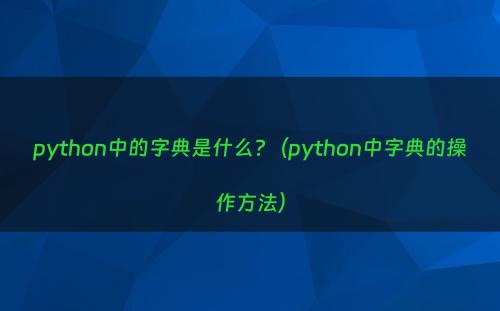“一起学习,一起成长!”
字典(dictionary)与列表类似,但其中元素的顺序无关紧要,因为它们不是通过像0或1的偏移量访问的。取而代之,每个元素拥有与之对应的互不相同的键(key),通过键来访问。键通常是字符串,但它还可以是Python中其他任意的不可变类型:布尔型、整型、浮点型、元组、字符串,以及其他一些在后面的内容会见到的类型。字典是可变的,因此你可以增加、删除或修改其中的键值对。

1. 使用{}创建字典
>>> empty_dict={}
>>> empty_dict
{}
>>> bierce={"day":"mostly misspent","positive":"one's voice","misfortune":"never misses"}
>>> bierce
{'day': 'mostly misspent', 'positive': "one's voice", 'misfortune': 'never misses'}
2. 使用dict()转换为字典
可以用dict()将包含双值子序列的序列转换成字典。
每个子序列的第一个元素作为键,第二个元素作为值。
>>> lol=[['a','b'],['c','d'],['e','f']]
>>> dict(lol)
{'a': 'b', 'c': 'd', 'e': 'f'}
可以对任何包含双值子序列的序列使用dict():
包含双值元组的列表:
>>> lot=[('a','b'),('b','d'),('e','f')]
>>> lot
[('a', 'b'), ('b', 'd'), ('e', 'f')]
>>> dict(lot)
{'a': 'b', 'b': 'd', 'e': 'f'}
包含双值列表的元组:
>>> tol=(['a','b'],['c','d'],['e','f'])
>>> dict(tol)
{'a': 'b', 'c': 'd', 'e': 'f'}
双字符的字符串组成的列表:
>>> los=['ab','cd','ef']
>>> dict(los)
{'a': 'b', 'c': 'd', 'e': 'f'}
双字符的字符串组成的元组:
>>> tos=('ab','cd','ef')
>>> dict(tos)
{'a': 'b', 'c': 'd', 'e': 'f'}
3. 使用[key]添加或修改元素
>>> python={}
>>> python={'a':'b','c':'d','e':'f','g':'h'}
>>> python
{'a': 'b', 'c': 'd', 'e': 'f', 'g': 'h'}
添加新键值对:
>>> python['new1']='new2'
>>> python
{'a': 'b', 'c': 'd', 'e': 'f', 'g': 'h', 'new1': 'new2'}
使用键修改值:
>>> python['new1']='new2-1'
>>> python
{'a': 'b', 'c': 'd', 'e': 'f', 'g': 'h', 'new1': 'new2-1'}
字典的键必须保证互不相同。如果创建字典时同一个键出现了两次,那么后面出现的值会取代之前的值:
>>> pythoon={'a':'b','a':'c','c':'d'}
>>> pythoon
{'a': 'c', 'c': 'd'}
4. 使用update()合并字典
使用update()可以将一个字典的键值对复制到另一个字典中去。
>>> python={'a':'b','c':'d','e':'f'}
>>> others={'age':26,'pay':'1236'}
>>> python.update(others)
>>> python
{'a': 'b', 'c': 'd', 'e': 'f', 'age': 26, 'pay': '1236'}
如果待添加的字典与待扩充的字典包含同样的键会怎么样?新归入字典的值会取代原有的值:
>>> python2={'age':89}
>>> python.update(python2)
>>> python
{'a': 'b', 'c': 'd', 'e': 'f', 'age': 89, 'pay': '1236'}
5. 使用del删除具有指定键的元素
>>> del python['age']
>>> python
{'a': 'b', 'c': 'd', 'e': 'f', 'pay': '1236'}
>>> del python['a']
>>> python
{'c': 'd', 'e': 'f', 'pay': '1236'}
6. 使用clear()删除所有元素
使用clear(),或者给字典变量重新赋值一个空字典({})可以将字典中所有元素删除:
>>> python.clear()
>>> python
{}
>>> python={}
>>> python
7. 使用in判断是否存在
如果希望判断某一个键是否存在于一个字典中,可以使用in。
>>> python={'a':'b','c':'d','e':'f'}
>>> 'a' in python
True
>>> 'f' in python
False
8. 使用[key]获取元素
这是对字典最常进行的操作,只需指定字典名和键即可获得对应的值:
>>> python['a']
'b'
如果字典中不包含指定的键,会产生一个异常:
>>> python['f']
Traceback (most recent call last):
File "<stdin>", line 1, in <module>
KeyError: 'f'
有两种方法可以避免这种情况的发生。第一种是在访问前通过in测试键是否存在:
>>> 'f' in python
False
另一种方法是使用字典函数get():
>>> python.get('a')
'b'
反之,若键不存在,如果指定了可选值,那么get()函数将返回这个可选值:
>>> python.get('f','not in python')
'not in python'
否则,会得到None(在交互式解释器中什么也不会显示):
>>> python.get('f',None)
>>>
9. 使用keys()获取所有键
使用keys()可以获得字典中的所有键。
>>> python.keys()
dict_keys(['a', 'c', 'e'])
但在python3中,你只能自己调用list()将dict_keys转换为列表类型。
>>> list(python.keys())
['a', 'c', 'e']
在python3里,同样需要手动使用list()将values()和items()返回值转换为普通的python列表。
10. 使用values获取所有值
使用values()可以获取字典中的所有值:
>>> list(python.values())
['b', 'd', 'f']
11. 使用items()获取所有键值对
使用items()函数可以获取字典中所有的键值对:
>>> list(python.items())
[('a', 'b'), ('c', 'd'), ('e', 'f')]
12.诚邀扫描下方二维码关注公众号,一起学习,一起成长! 使用=赋值,使用copy()复制
与列表一样,对字典内容进行的修改会反映到所有与之相关联的变量名上:
>>> python={'a':'b','c':'d','e':'f'}
>>> python_new=python
>>> python_new
{'a': 'b', 'c': 'd', 'e': 'f'}
>>> python['a']='g'
>>> python
{'a': 'g', 'c': 'd', 'e': 'f'}
若想避免这种情况,可以使用copy()将字典复制到一个新的字典中:
>>> python_new1=python.copy()
>>> python_new1
{'a': 'g', 'c': 'd', 'e': 'f'}
>>> python_new1['a']='u'
>>> python_new1
{'a': 'u', 'c': 'd', 'e': 'f'}
「亲,如果笔记对您有帮助,收藏的同时,记得给点个赞、加个关注哦!感谢!」
「诚邀关注公众号“issnail”,会有惊喜哦!感谢!」
「文中代码均亲测过,若有错误之处,欢迎批评指正,一起学习,一起成长!」
参考书目:python语言及其应用
